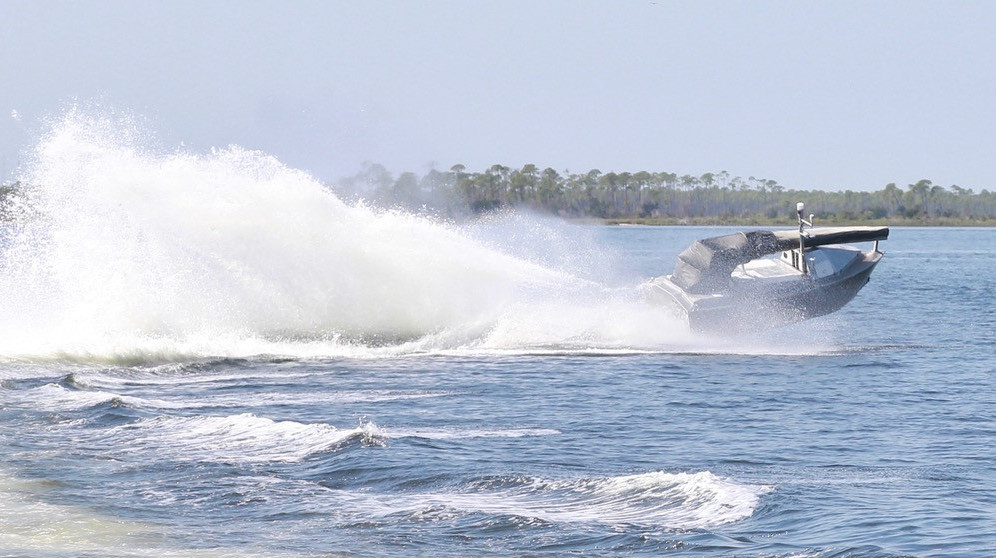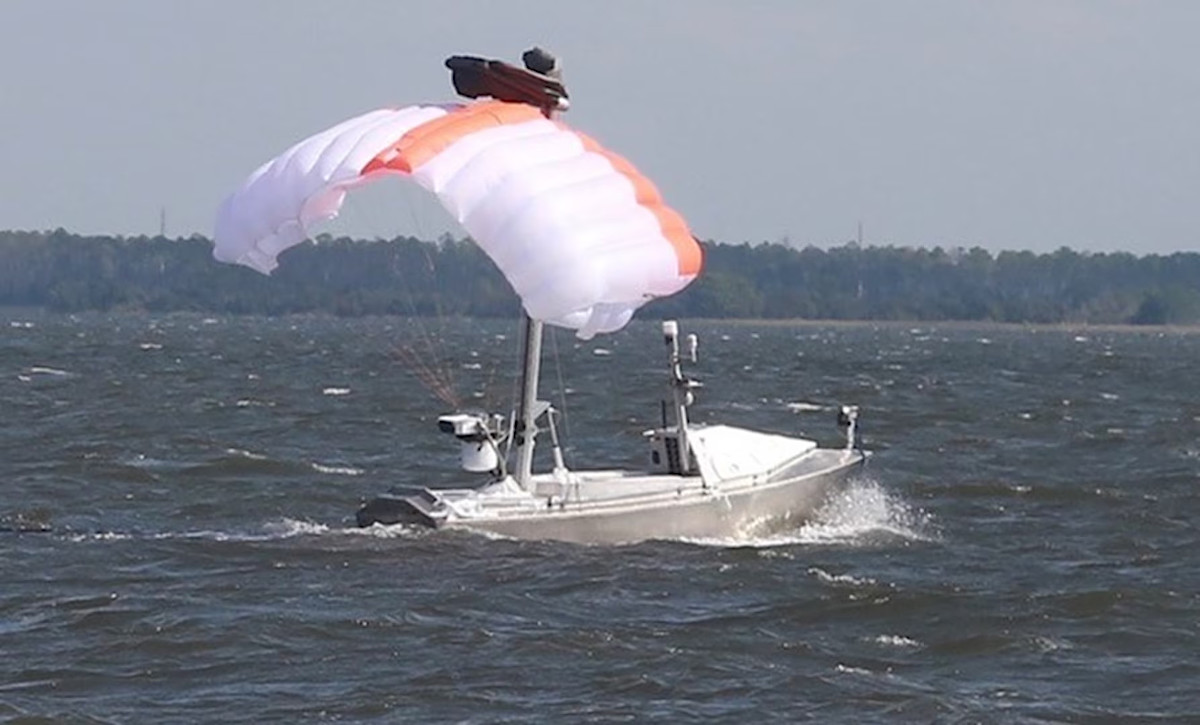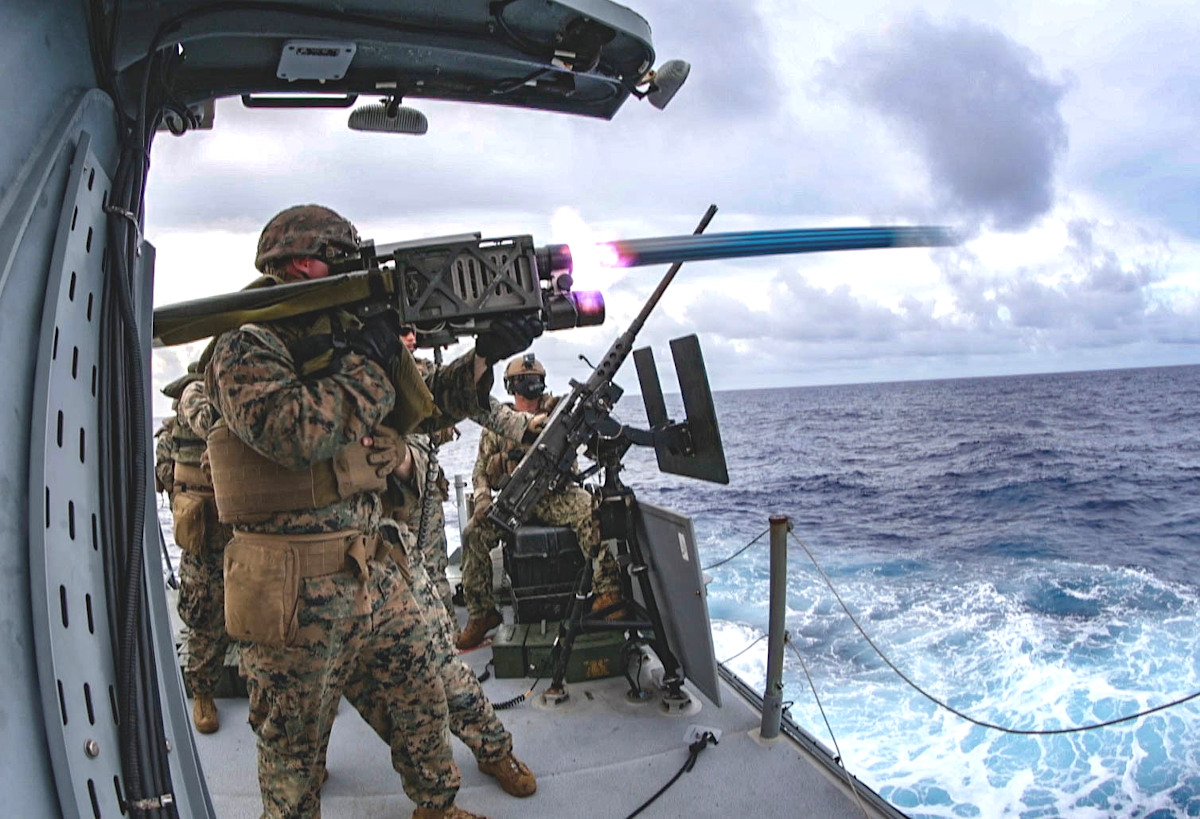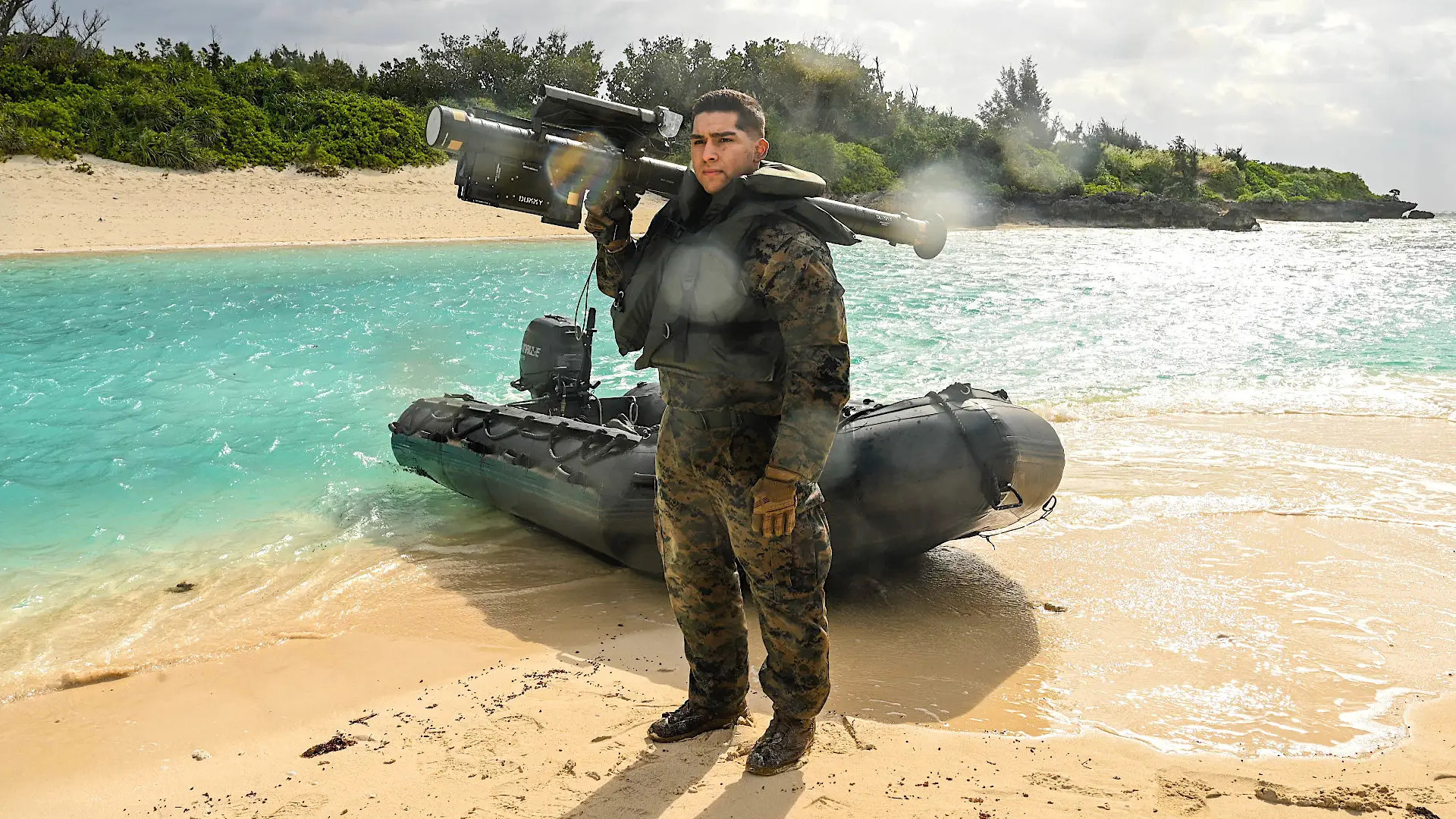The U.S. Navy wants to explore the idea of using small uncrewed surface vessels, or USVs, armed with Stinger missiles as a relatively low-cost additional layer of defense against various threats in the air and on the surface of the water. The service says it is particularly interested in the possibility of using the drone boats to help protect critical, but ever-more-vulnerable logistics vessels, as well as Marine contingents during future expeditionary and distributed operations.
Details about what the Navy is currently referring to as Multi-domain Area Denial from Small-USV, or MADS, are contained within its recently released budget request for the 2024 Fiscal Year. The service is asking for $5 million to support this experimentation effort.
The Navy’s proposed Fiscal Year 2024 budget does not provide specific details on how the MADS USVs might be configured. It does say that at least the experimental examples will be based on the Greenough Advanced Rescue Craft (GARC) design.

Developed by the Maryland-based Maritime Applied Physics Corporation (MAPC), the baseline GARC design is 15 feet and eight inches long, five feet and eight inches at its widest, and has a relatively low profile. MAPC says it has a 1,000-pound payload capacity. It can hit a top speed of at least 35 knots and has a stated maximum range of over 700 nautical miles using its standard diesel-fueled propulsion system when sailing at just six knots, according to the manufacturer. The company says that it can also travel over 400 nautical miles at a more brisk speed of 30 knots.
The control system for the USV can be set up to use line-of-sight and beyond-line-of-sight links and allows for direct “remote control, route following, [and] loitering modes,” according to a company product card. It also provides “real-time situational awareness data streamed for safe navigation” for human operators.

The Navy has been testing examples of the GARC since at least 2018 as communications relay nodes and potential escort platforms. It’s not immediately clear if any of those tests have included the live-firing of weapons, but MAPC says that the drone boat can be fitted with various weapon packages. This includes the Kongsberg Sea Protector Remote Weapon Station (known in the U.S. Navy as the Mk 50 Gun Weapon System), which can be fitted with various types of machine guns and 40mm automatic grenade launchers, as well as another type equipped with the .50 caliber GAU-19 rotary barrel machine gun and systems capable of firing AGM-176 Griffin or AGM-114 Hellfire missiles. No mention appears to be made of Stinger in the company’s marketing materials.
The video below focuses on the use of the GARC as a rescue platform, but features footage of examples with different remote stations, among other capabilities demonstrations.

MAPC also says the GARC can carry various sensor packages, including full-motion video cameras and signals intelligence suites, sonars and other systems to help spot and track enemy submarines, and equipment to aid in the detection and neutralization of naval mines. It can be configured to deploy its own smaller uncrewed underwater vehicles and tethered (via data link) drones, as well.
“Initial technical feasibility will be established early through a number of land-based smaller system integration and experimentation efforts,” the Navy’s 2024 Fiscal Year budget request notes. While no specific systems are named here, there are a number of remote weapon stations for use on ground-based platforms in service already across the U.S. military that include launchers for the FIM-92 Stinger that could be leveraged for MADS.

The MADS line item also says that the goal is for the USV to have the means to both detect and engage targets onboard. This would, of course, not preclude the possibility of networking the groups of USVs together, as well as to other platforms, to provide for distributed target detection and cueing. This would provide additional flexibility and help increase the probability of successfully spotting and engaging targets across a broader area.
GARC itself can be fitted with a Towed Airborne Lift of Naval Systems (TALONS), which is a tethered parasail capable of providing an elevated platform for various equipment. In one test in 2019, a TALON on a GARC was used to loft a communications relay package. It could also be used to give sensors a wider field of view, something the Navy has demonstrated by combining TALONS with other USVs in the past.

We don’t just how autonomous the Navy might ultimately want these platforms to be. However, the plan as described in the 2024 Fiscal Year budget request involves a link to some other node, where a human being would at least be present in the fire control loop at all times.
Interestingly, the Navy also says that wants to explore using the MADS USVs to provide a “persistent anti-air and anti-surface maritime defense capability.” Stinger is primarily treated as a surface-to-air and air-to-air weapon, and this raises questions about how readily adaptable it might be to the surface-to-surface role. However, the latest variants in U.S. service have been upgraded to have increased capability against targets with lower infrared signatures, like drones, and the missile’s warhead should be sufficient for engaging lower-end surface threats, such as small boats.

It is worth noting that the latest variant of the French Mistral, a broadly similar missile to the Stinger, has a demonstrated capability in this regard, but it also features an infrared imaging seeker. An upgraded version of Stinger with an imaging infrared seeker was under development for the U.S. Army, starting in 1996, but growing delays led to that project being canceled in 2002.

The Navy could seek to revive the development of such a Stinger variant for the MADS effort. The Army is also looking to initiate the development of a Stinger replacement that is more lethal, has a longer range, and is otherwise more capable than its predecessor. It also to be able to be fired from existing launchers and the Army is interested in a networking capability so that it can take advantage of various offboard sensors, as you can read about more here.
It is also possible that whatever Stinger-armed weapon system would be used for this project might have one or more secondary weapons capable of engaging surface targets. A single remote weapon station could be configured with a gun of some kind, as well as the ability to fire other kinds of missiles, like Hellfire or Javelin, in addition to stingers. A larger group of USVs could include examples carrying weapons packages better optimized overall for the anti-surface role, complementing Stinger-armed types, too.
Much of this could well be among the questions the Navy wants to answer through the MADS experiment.
“The experiment will consist of a single sensor/shooter platform conducting live-fire engagements against air target drones to validate the hypothesis that low cost… small USVs with integrated weapons offer a capable stand-off area denial system,” the Navy’s 2024 Fiscal Year budget request says in explaining its near-term goals for MADS. “The experimentation will develop and validate CONOPS [concepts of operations] and TTP [tactics, techniques, and procedures] for employment of MADS. Modeling and simulation, such as Table Top Exercise (TTX) wargaming, will be used to close in and/or refine architectural frameworks in support of USN and USMC joint operations.”
The potential value of large groups of small, lower-cost USVs armed with Stingers just as additional layers of defense against lower-end air and missile threats across broader areas is clear. The current generation of Stinger missiles has improved capabilities against subsonic cruise missiles and drones. Both of these categories of weapons present very real threats now to U.S. forces at sea and on land, and are proliferating among smaller military forces and even non-state actors. The Navy is especially familiar with the potential threat that drones present outside of traditional conflicts, too, after repeated incidents in and around the United States and elsewhere around the world.
In a major conflict against a potential near-peer adversary, such as China or Russia, the volume of those kinds of strikes is also likely to be very high, creating a demand for additional air and missile defense capacity, in general.

These are all issues the Navy itself outlines in its most recent proposed budget in the MADS line item.
“Peer or near peer competitors are building naval forces that will soon be significantly more numerous than those of the US Navy and our allies. During future conflicts, US and allied forces will be greatly outnumbered by peer or near peer competitors in both tactical platforms and munitions,” the MADS line item says by way of explaining the need for this capability. “To counter this threat, Distributed Maritime Operations (DMO) are planned that will require large numbers of smaller tactical platforms including unmanned surface vessels (USVs). Large numbers of small, low signature… unmanned missile launching vessels have the potential to improve surface force magazine depth and reduce risk to force in denied areas.”
The Navy also highlights how large groups of USVs performing this mission would present challenges to an opponent in terms of trying to neutralize those defenses in a timely and cost-effective manner. Utilizing uncrewed systems also reduce the risks to friendly forces and allows for a smaller number of actual personnel to provide coverage across a wide area.
“MADS is intended to be scaled… where multiple systems deployed simultaneously will overwhelm enemy kill chains as well as be difficult and costly to target,” the Navy’s latest budget proposal says. “The resulting capability would be unmatched in terms of size, endurance, and cost and is suitable for littoral, chokepoint, and EABO operations, and organic stand-off defense for manned naval vessels such as MSC [Military Sealift Command ships of USTRANSCOM.”
EABO here refers to Expeditionary Advance Base Operations, which is at the core of the Marine Corps’ new concepts of operation for future expeditionary and distributed operations. EABO focuses heavily on the ability of relatively small groups of Marines to readily establish bases in forward areas, including remote and austere locales like islands in the western Pacific, and then be able to equally quickly relocate to new spots. Lower-cost, rapidly deployable defenses of various kinds are set to be critical for these elements, which are expected to be able to operate effectively well within the range of enemy stand-off weapons.
With all this in mind, the Marine Corps has actively been experimenting with different means of employing Stinger missiles in their man-portable configuration to support expeditionary and distributed operations. This has included deploying Stinger teams in small rubber rafts, as well as aboard Navy Mk VI patrol boats. The Navy is in the process of divesting the latter vessels.

The Marines, as well as the Navy, have a long history of employing the Stinger for shipboard defense, too. The Marine Corps is also increasingly looking at the AH-1Z Viper attack helicopter as a means of providing additional air defense capacity, including against drones.
Perhaps more important is the specific mention here of helping to protect the Navy’s MSC ships, which include a host of critical support vessels. The U.S. military relies heavily on the ability to move forces and supplies via the sea to support operations around the world. The Navy, in particular, uses support ships for replenishment at sea to reduce the need for established port facilities in forward areas and is now actively looking at new concepts for ship-to-ship rearming of warships.
At the same time, concerns have been growing for years about the vulnerability of these support ships and the ability of the U.S. military to ensure unbroken logistics chains more generally in contested environments. The War Zone has explored in depth in the past the resource-intensive complexities of maritime convoy operations.
Though the Navy is interested in MADS being able to provide “organic stand-off defense for manned naval vessels,” whether small USVs like GARC would be able to provide that additional protection on the open seas remains a question. GARC has been tested “in 30 foot seas in Kadena, Japan,” according to MAPC.
Regardless, the extra defensive layer that MADS USVs would provide for logistics ships and other larger crewed vessels could still be useful in port, including during the loading or unloading of cargo, or in other inshore or near-shore environments. Even in peacetime contexts, the drone boats could provide valuable additional force protection assets for ships visiting foreign ports that might not otherwise have robust security features.
It does remain to be seen exactly what may come of the MADS effort, if it is indeed funded in the final Navy budget for the 2024 Fiscal Year. In the scheme of U.S. defense spending, $5 million is a relatively small amount, but the project is also clearly looking to leverage very mature assets and capabilities to prove out the core concept. The Navy could easily look to expand its size and scope in the future based on the outcome of the work in the upcoming fiscal cycle.
If the initial MADS experimentation produces good results, we could be seeing Stinger-armed drone boats helping to protect Navy and Marine forces in forward areas in the coming years.
Contact the author: joe@thedrive.com
